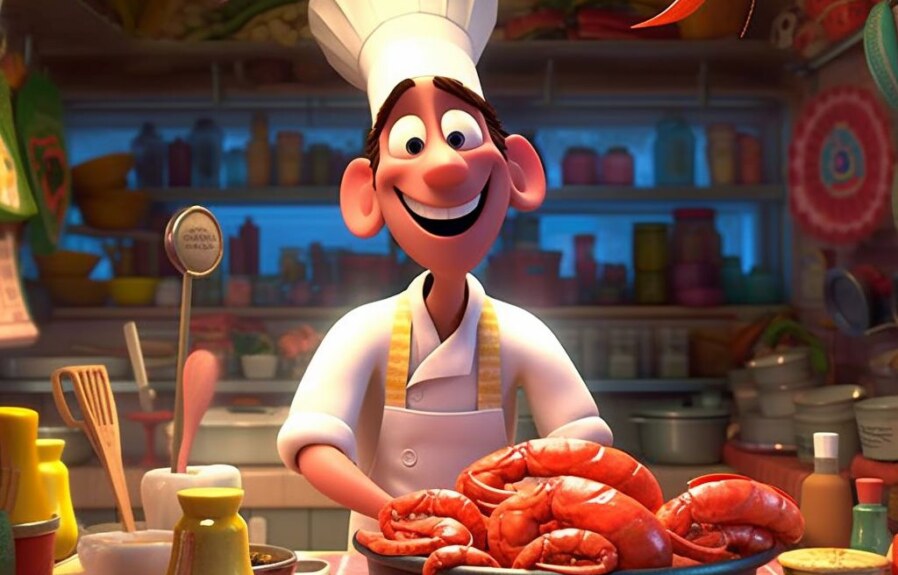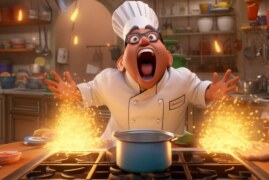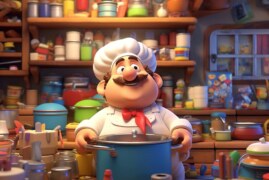Shrimp is a popular ingredient in many dishes, but cooking it to perfection can be tricky. Overcooked shrimp can become tough and rubbery while undercooked shrimp can be a health hazard. So, how do you know when shrimp is done? It may seem like a daunting task, but with a little know-how, you can ensure your shrimp is cooked to perfection every time. In this article, we’ll take a closer look at how to determine when shrimp is done cooking, so you can serve up the ultimate dish every time.
1. The Art of Shrimp Cooking: A Comprehensive Guide to Determine When Your Shrimp Is Done
Shrimp is a popular dish all around the world, and it’s no wonder why! Shrimp is a versatile food that can be cooked in various ways, and there are so many delicious recipes that you can try out. However, one of the most critical aspects of cooking shrimp is to determine when it’s done. Shrimp is delicate and cooks quickly, making it easy to overcook or undercook.
Timing Matters: How to Tell When Shrimp is Cooked Perfectly
Timing is crucial when cooking shrimp. Depending on the size of the shrimp, it can take anywhere from 1-3 minutes to cook thoroughly. The best way to know when your shrimp is done is to observe the color. The shrimp’s exterior should turn pink and opaque, and the flesh should be white with no signs of gray.
Feeling Through Your Cooking: A Step-by-Step Guide to Checking Shrimp Doneness
Another way to determine when your shrimp is done is to feel it while cooking. When the shrimp has curled up and feels firm to the touch, it is cooked. However, it is essential to handle the shrimp with care to avoid overcooking it.
Don’t Overdo It: Tips on Avoiding Overcooked or Undercooked Shrimp
Overcooking or undercooking shrimp can impact the quality and taste of your dish. Overcooked shrimp will be rubbery and chewy, while undercooked shrimp may be raw and unsafe to eat. To avoid these issues, ensure that you pay close attention to the cooking time, color, and texture of the shrimp while cooking.
Different Cooking Methods, Different Doneness: How to Gauge Your Shrimp Depending on the Recipe
Different cooking methods and recipes require varying levels of doneness when cooking shrimp. For example, if you plan to stir-fry the shrimp, the shrimp should be slightly undercooked as it will continue cooking once it is removed from the heat. On the other hand, if you are grilling shrimp, you will need to ensure it’s thoroughly cooked.
Common Mistakes and How to Avoid Them When Cooking Shrimp
One of the most common mistakes when cooking shrimp is overcooking it. Overcooking shrimp can result in a tough, rubbery texture that is unappetizing to eat. Other mistakes include using frozen shrimp without thawing it, adding too much seasoning or salt, or not cleaning the shrimp correctly.
Mastering the Art of Cooking Shrimp: Tips from Expert Chefs
According to expert chefs, the key to cooking perfect shrimp is to ensure that you don’t overcook or undercook it. They suggest that you should always buy fresh shrimp and avoid freezing it for an extended period. Additionally, they recommend that you season your shrimp lightly and don’t overcrowd the pan while cooking. By following these tips, you can cook the perfect shrimp dish and impress your guests every time!
2. Timing Matters: How to Tell When Shrimp is Cooked Perfectly
Shrimp is a favorite seafood that is enjoyed in many dishes around the world. Whether you are boiling, baking, grilling, or sautéing shrimp, it is essential to know when it is perfectly cooked to avoid foodborne illnesses and to bring out the best taste and texture. Here are a few tips on how to determine the perfect timing to cook shrimp.
Boiling Shrimp
Boiling is the most common way of cooking shrimp. Boiling time usually ranges from 2 to 4 minutes, depending on the size of the shrimp. Small shrimp will cook faster than large shrimp. The best way to tell when the shrimp is done is by checking its color. Perfectly boiled shrimp should be pinkish white and slightly opaque. Avoid boiling the shrimp for too long, as it will result in overcooked and tough shrimp.
Grilling Shrimp
Grilling shrimp is an excellent way to bring out its natural flavor. Grilling time will depend on the size and type of shrimp you are grilling. Shrimp cook fast; therefore, you must keep a close watch to prevent overcooking. One way to tell if the shrimp is ready to flip is when it starts to curl and turn opaque. Flip the shrimp, and grill for another 2 to 4 minutes, depending on size. When the shrimp turns pink and is slightly charred on the edges, it is perfectly cooked.
Sautéing Shrimp
Sautéing shrimp requires a fast cooking time, usually in 2-3 minutes. The best way to tell when sautéed shrimp is done is by checking its firmness. The shrimp should be medium-firm and slightly translucent in the center. To avoid overcooking, remove the shrimp from the heat once it is no longer gray or translucent. Overcooked shrimp becomes rubbery and loses its delicate texture and flavor.
In conclusion, timing is a crucial factor in cooking shrimp perfectly. Knowing when to remove the shrimp from the heat and check its color and firmness will help you avoid under or overcooking it. Different cooking methods require different cooking times, but knowing when shrimp is perfectly cooked will guarantee a delicious and safe dish every time.
3. Feeling Through Your Cooking: A Step-by-Step Guide to Checking Shrimp Doneness
Determining the perfect doneness of shrimp is more than following the cooking time noted in a recipe. Sure, this can give an idea of when the shrimp is cooked, but it might not always be accurate. This is why feeling through your cooking is a critical skill when it comes to cooking shrimp.
Here are some step-by-step guides to help you figure out how to tell if your shrimp is done:
Step 1: Look at the Shrimp
First, look at the shrimp’s color. If it’s raw or uncooked, it will have a translucent grey color. As it cooks, the flesh will turn from grey to pink, and then orange-ish when it’s fully cooked. The shrimp will also start to curl once it’s cooked.
Step 2: Check the Texture
The texture is also another aspect to consider. If your shrimp is overcooked, it will have a rubbery texture that feels tough and chewy in your mouth. If it’s undercooked, the shrimp will feel raw and slimy.
Step 3: Use a Thermometer
A more foolproof method of checking for shrimp doneness is to use a thermometer. The FDA recommends that shrimp should be cooked until it reaches an internal temperature of 145°F. Insert the thermometer into the thickest part of the shrimp to make sure you’re getting an accurate reading.
Keep these tips in mind when cooking shrimp to help you achieve the perfect doneness every time. Knowing how to determine when your shrimp is cooked just right is an essential talent for any home cook.
4. Don’t Overdo It: Tips on Avoiding Overcooked or Undercooked Shrimp
When it comes to cooking shrimp, timing is everything. Overcook it, and you’ll end up with a rubbery and chewy texture. Undercook it, and you run the risk of contracting food poisoning. It is essential to avoid both scenarios by following the tips outlined below.
Avoid Overcooking Shrimp
One of the primary reasons for overcooking shrimp is leaving it in the heat for too long. Keep an eye on the shrimp as they cook and remove them from the heat immediately when they are done. If you’re cooking on high heat, it’s crucial to be vigilant and use the timer frequently. If your shrimp is already cooked, it will turn pink and curl up slightly.
Avoid Undercooking Shrimp
Undercooked shrimp might be harmful to your health, and it’s best to avoid it by cooking the shrimp completely. If you want to know when shrimp is done, check for a few hints. The flesh should have turned opaque, with no gray areas, and the texture should be firm yet not too tight. If the flesh of the shrimp is still translucent, keep cooking it until it turns opaque.
Use a Food Thermometer
For an accurate reading on whether the shrimp is cooked, use a food thermometer to determine the temperature. You can do this by inserting the thermometer in the thickest part of the shrimp’s flesh. The reading should be between 120-145 degrees Fahrenheit. If it’s lower than that, transfer the shrimp back to the stove for further cooking.
By following these tips, you can avoid the common pitfalls of undercooking or overcooking shrimp. With a little bit of practice, you’ll know when your shrimp is cooked to perfection every time.
5. Different Cooking Methods, Different Doneness: How to Gauge Your Shrimp Depending on the Recipe
How to Know When Shrimp is Done?
Different cooking methods can affect the doneness of shrimp. To achieve the perfect texture and flavor, it’s essential to know the cooking method and gauge the shrimp’s doneness accordingly. Here are some common cooking methods and how shrimp should look when they are done.
Boiling
Boiling is one of the simplest methods of cooking shrimp. In a boiling pot of salted water, shrimp should take 2-3 minutes to cook thoroughly. As the shrimp cook, they will start to turn pink and curl up slightly. Overcooking the shrimp can cause them to turn tough and rubbery, so it’s essential to remove them from the heat as soon as they are done.
Grilling
Grilling is a popular cooking method for shrimp, and it’s an excellent way to add smoky flavors to the shrimp. When grilling, shrimp should take 2-3 minutes per side to cook through. The outside of the shrimp should turn pink and have grill marks, and the flesh inside should turn opaque.
Sautéing
Sautéing is an ideal cooking method for shrimp when you want to create a flavorful dish quickly. In a hot pan, shrimp should take 1-2 minutes per side to cook through. As the shrimp cook, they will turn pink, and the flesh inside will turn opaque.
Baking
Baking is an excellent method to cook large quantities of shrimp. When baking shrimp, they should take around 10-12 minutes to cook through. As the shrimp cook, they will turn pink, and the flesh inside will turn opaque.
In summary, different cooking methods have varying cooking times, and it’s essential to gauge your shrimp’s doneness depending on the recipe. Be mindful not to overcook the shrimp, as this can cause them to turn chewy and rubbery. Knowing the cooking method and gauging the shrimp’s doneness accordingly can help achieve the perfect texture and flavor.
6. Common Mistakes and How to Avoid Them When Cooking Shrimp
When cooking shrimp, it is not uncommon to encounter some mistakes that can affect the outcome of your dish. Here are some of the most common mistakes and tips on how to avoid them.
Not Prepping Shrimp Properly
One of the most common mistakes when cooking shrimp is not properly prepping it. This includes:
– Not deveining the shrimp: Deveining your shrimp is important as it removes the digestive tract and any potential bacteria. If you leave it in, it can affect the taste and texture of the shrimp.
– Not removing the shell: Some recipes call for peeled shrimp while others require the shell to be intact. Make sure you read the recipe carefully before prepping your shrimp.
– Not thawing frozen shrimp properly: Thawing frozen shrimp on the counter or in warm water can be dangerous as it can cause bacteria to grow. The best way to thaw shrimp is by placing it in the refrigerator overnight.
Tip: Make sure you prep your shrimp properly before cooking it to ensure the best possible outcome.
Overcooking Shrimp
Overcooking shrimp can result in a rubbery texture and a fishy taste, which is not ideal. Some tips on how to avoid overcooking your shrimp include:
– Timing is key: Shrimp cooks quickly, so keep an eye on it and remove it from the heat as soon as it turns pink and opaque.
– Cook it in batches: If you’re cooking a large amount of shrimp, it’s better to cook it in batches to avoid overcooking.
– Don’t boil shrimp: Boiling shrimp can cause it to become overcooked and tough. Instead, sauté, grill or bake it.
Tip: Pay close attention to the cooking time and avoid boiling shrimp to prevent overcooking it.
Mixing Different-sized Shrimp
When cooking shrimp, it is important to use shrimp of the same size. Mixing different-sized shrimp can lead to uneven cooking times, resulting in overcooked or undercooked shrimp.
Tip: When buying shrimp, look for ones that are the same size, or if possible, buy them in a bag that contains shrimp of the same size.
By avoiding these common mistakes and following the tips above, you can ensure that your shrimp dishes turn out delicious every time.
7. Mastering the Art of Cooking Shrimp: Tips from Expert Chefs
Learn from the masters! The following are tips and tricks from expert chefs on how to cook shrimp to perfection:
Use an Instant-Read Thermometer
Chef Danielle Espiritu suggests using an instant-read thermometer to ensure that the internal temperature of the shrimp reaches 120-125°F. This will guarantee that the shrimp is cooked through but still succulent and tender.
Cook Shrimp Separately
According to Chef Anthony Endy, one of the biggest mistakes home cooks make when cooking shrimp is adding them to a dish when the other ingredients are still cooking. Instead, he recommends cooking the shrimp separately and then adding them to the dish at the end. This way, the shrimp will not be overcooked and will retain their natural sweetness and texture.
Properly Store Shrimp
Chef Brook Harlan emphasizes the importance of properly storing shrimp before cooking. Shrimp should be kept chilled in the refrigerator and used within two days of purchase. If you are using frozen shrimp, make sure to thaw them properly in the refrigerator overnight. This will ensure that your shrimp is fresh and safe to eat.
With these tips from the experts, you’ll be able to cook shrimp like a pro in no time!
People Also Ask
How do you know when shrimp is fully cooked?
When shrimp is fully cooked, it will turn pink and opaque. The flesh should be firm to the touch but not rubbery. Overcooked shrimp will be tough, chewy, and unappetizing.
How long do you cook shrimp?
The cooking time for shrimp will depend on the method and size of the shrimp. As a general rule, it takes 2-3 minutes to cook medium-sized shrimp in boiling water or steaming, 3-4 minutes in a sauté pan, and 6-8 minutes on a grill.
Can you eat raw shrimp?
It is not recommended to eat raw shrimp as it may contain harmful bacteria or parasites that can cause food poisoning. Cooking shrimp thoroughly will kill any bacteria and make it safe to eat.
Can you overcook shrimp?
Yes, shrimp can be easily overcooked, resulting in a tough and rubbery texture. To avoid overcooking, keep an eye on the appearance of the shrimp, and cook it until it turns pink and opaque, but not longer than that.
What is the best way to cook shrimp?
The best way to cook shrimp depends on personal preference and the desired outcome of the dish. Some popular methods include boiling, grilling, sautéing, and baking. Shrimp can also be served raw in sushi or ceviche dishes.
Conclusion
Knowing when shrimp is done is crucial to avoid overcooking or undercooking and serve it at its best. Shrimp should be cooked until it turns pink and opaque, but not longer than that to avoid toughness. The cooking time will depend on the method and size of the shrimp, and there are many ways to cook shrimp depending on personal preference and the desired result. Avoid eating raw shrimp as it may contain harmful bacteria or parasites.



